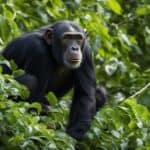Chimpanzees, our closest relatives in the animal kingdom, have developed incredible adaptations that allow them to thrive in their diverse environments. From their physical characteristics to their behavioral and ecological strategies, chimpanzees have evolved unique survival strategies that have enabled their species to endure and flourish. In this article, we will explore the fascinating world of chimpanzee adaptations, encompassing their habitat adaptation, evolutionary changes, survival strategies, behavioral modifications, physical attributes, and ecological adjustments. By understanding these remarkable adaptations, we can gain a deeper appreciation for the astounding abilities of these intelligent and resourceful primates.
Chimpanzee adaptation is an intricate combination of physical traits, behavioral nuances, and genetic differences that enable them to thrive in specific environments. These adaptations have played a vital role in their survival and ability to overcome the challenges posed by various habitats. Join us as we explore the world of chimpanzee adaptation and discover the remarkable strategies they utilize to navigate and conquer the diverse environments they call home.
Chimpanzee Adaptations & Survival in the Tropical Rainforest Environment
In the tropical rainforest, chimpanzees have developed remarkable adaptations that enable their survival in this challenging environment. Their ability to adapt has allowed them to thrive in the dense vegetation and abundant resources of the rainforest.
Chimpanzees in the tropical rainforest have harnessed the power of tools to enhance their foraging capabilities. They use tools to extract termites, ants, and honey from hard-to-reach places. This ingenious adaptation not only provides them with essential nutrients but also demonstrates their problem-solving skills and intelligence.
Furthermore, chimpanzees have discovered certain plants within their surroundings that assist in ridding their digestive systems of parasites. This adaptation showcases their knowledge of the rainforest’s medicinal properties and their ability to self-medicate.
Chimpanzees possess a unique locomotion technique known as forelimb-suspension. This adaptation allows them to swing effortlessly from tree branches, navigating the rainforest canopy with agility and grace. Their hind legs, on the other hand, are well-suited for walking on the ground, ensuring their mobility in both arboreal and terrestrial environments.
In addition to their physical adaptations, chimpanzees in the tropical rainforest possess large brains. These brains are critical for their decision-making abilities, helping them navigate the complex social dynamics and resource competition within their communities.
Communication is also essential for chimpanzee survival in the rainforest. They express their emotions and intentions through a variety of means, including facial expressions, body language, and vocalizations. This complex system of communication enables them to navigate social interactions, establish dominance hierarchies, and foster cooperation within their social groups.
Chimpanzee Physical Adaptations
Chimpanzees possess a range of physical characteristics and adaptations that enable their survival in various environments. These adaptations include:
- Opposable Thumbs: Chimpanzees have opposable thumbs, allowing them to grasp and climb trees with exceptional dexterity. This adaptation enables them to navigate their arboreal habitat and use tools to find food.
- Strong Arms and Broad Soles: With their strong arms and broad, hard soles, chimpanzees swing effortlessly from tree branches in a behavior known as brachiation. This locomotion helps them cover great distances and swiftly move through the forest canopy.
- Sharp Canine Teeth: Chimpanzees possess sharp canine teeth that aid in self-defense and tearing apart prey when hunting. These teeth serve as essential tools for survival in their natural habitat.
- Nest Building: Chimpanzees construct nests on treetops for resting and safety. These nests provide them with security during sleep, protecting them from ground-dwelling predators.
These physical adaptations are crucial for chimpanzees to effectively navigate their surroundings, secure food, defend themselves, and ensure their overall survival.

Chimpanzee Behavioral Adaptations
Chimpanzees are known for their complex social behaviors and remarkable communication skills. These highly intelligent primates live in large social groups, forming intricate relationships with one another. In order to survive and thrive, chimpanzees have developed various behavioral adaptations that allow them to navigate their environments effectively.
One of the key behavioral adaptations of chimpanzees is their ability to cooperate in catching prey and defending territories. Living in large social groups provides them with the advantage of safety in numbers, as they work together to hunt and protect their resources. This cooperative behavior not only enhances their chances of success but also strengthens social bonds within the group.
Communication plays a crucial role in the lives of chimpanzees. These primates use facial expressions, body language, and vocalizations to express their emotions and convey messages to one another. Through these forms of communication, chimpanzees can establish social hierarchy, resolve conflicts, and express their needs and intentions.
Chimpanzees also possess the ability to learn and teach others, demonstrating their advanced cognitive capabilities. Their large brains and special neurons associated with decision-making enable them to observe, imitate, and share knowledge within their social groups. This learning and teaching behavior is essential for transmitting and preserving important skills and cultural practices among the chimpanzee population.
Overall, chimpanzee behavioral adaptations contribute to their survival and success in their respective habitats. Their cooperative nature, sophisticated communication skills, and aptitude for learning and teaching set them apart as highly adaptable and intelligent animals.
Examples of Chimpanzee Behavioral Adaptations
| Adaptation | Description |
|---|---|
| Cooperative hunting | Chimpanzees work together to catch prey, increasing their chances of success. |
| Territorial defense | Chimpanzees band together to protect their territories from intruders and rival groups. |
| Facial expressions | Chimpanzees use a wide range of facial expressions to communicate their emotions and intentions. |
| Body language | Gestures and postures are used by chimpanzees to convey messages and establish social hierarchy. |
| Vocalizations | Chimpanzees produce various vocalizations to communicate with one another, ranging from loud calls to gentle vocal cues. |
| Learning and teaching | Chimpanzees have the ability to learn from their peers and pass on acquired knowledge to younger individuals. |
Chimpanzee Ecological Adaptations
Chimpanzees have showcased remarkable ecological adaptations that allow them to thrive in a variety of habitats. From lush tropical rainforests to vast open grasslands, these intelligent creatures have demonstrated their ability to adapt to different environmental conditions.
In tropical forests, chimpanzees have adapted to their habitat by using their ecological intelligence to exploit available resources. They have a preference for areas abundant in tree fruits, their primary food source. However, their diet is not limited to fruits alone. Chimpanzees have also been observed feeding on leaves, termites, ants, and even hunting larger animals for sustenance.
“Chimpanzees are opportunistic eaters, adapting their diet to the resources available in their environment.”
Their genetic makeup plays a crucial role in these adaptations. Genetic variations between populations allow them to have specific traits that help them adapt to their local environments. These adaptations are essential for their survival.
Although chimpanzees are highly adaptable, their ability to thrive in diverse habitats is heavily dependent on the conservation of their ecosystems. Habitat destruction poses a significant threat to their survival. It is imperative that we take measures to protect and preserve their habitats, ensuring the continuity of their ecological adaptations and the sustainability of their populations.
| Habitat | Main Adaptations |
|---|---|
| Tropical rainforests | Use of tools, tree swinging locomotion, communication through facial expressions |
| Open grasslands | Opportunistic feeding, cooperative hunting, social behaviors |
| Mountain regions | Altitude adaptation, foraging strategies, high degree of manual dexterity |
| Deciduous woodlands | Seasonal food adaptation, nest-building, territorial defense |
The versatility of chimpanzees in adapting to different environmental habitats highlights their resilience as a species. By protecting their habitats, we can ensure the survival of these magnificent creatures for generations to come.
Genetic Adaptation to Environment
Genetic adaptations play a crucial role in the survival and evolution of chimpanzees. Scientists have discovered genetic differences between different populations of chimpanzees, leading to the classification of subspecies. These genetic adaptations have occurred as a result of the unique environmental conditions in their respective habitats.
Chimpanzees have adapted genetically to specific challenges they face in their environments. These adaptations allow them to maximize their chances of survival and thrive in their particular habitats.
To illustrate the genetic adaptations of chimpanzees, consider the example of their immune system. Different populations of chimpanzees may have evolved specific genetic variants that provide increased resistance to the prevalent diseases found in their respective habitats.
Understanding these genetic adaptations is crucial for conservation efforts. Conserving the unique genetic diversity found in different populations of chimpanzees is essential for their long-term survival. Habitat loss and other threats to their existence make conservation efforts even more critical.
Conclusion
Chimpanzees have demonstrated remarkable adaptations that enable their survival in diverse environments. Through physical, behavioral, and genetic changes, they have evolved strategies to navigate their habitats and ensure their long-term existence.
Their opposable thumbs provide them with the dexterity needed to grasp and manipulate objects, allowing them to use tools for various purposes, including foraging and defense. Additionally, sensory adaptations enable them to detect predators and locate food sources, contributing to their successful survival strategies.
Their large brains not only facilitate complex decision-making but also support intricate social behaviors. Chimpanzees live in cooperative social groups, where they share hunting techniques, defend territories, and communicate through facial expressions, body language, and vocalizations.
However, despite their incredible adaptations, chimpanzees face significant threats, primarily due to habitat loss. Conservation efforts are crucial to protect their natural environments and ensure the continued survival of these intelligent and adaptable creatures in the face of ongoing environmental challenges.
How does the way chimpanzees build their nests contribute to their adaptation to their environments?
Chimpanzees’ nest building behavior plays a crucial role in their adaptation to their environments. By carefully selecting sturdy branches and creating elevated, comfortable structures, chimpanzees protect themselves from ground predators and insects. This behavior also fosters social bonding and teaches younger members essential survival skills.
What are the specific adaptations that chimpanzees have developed to cope with the effects of climate change in their habitats?
Chimpanzees and climate change have forced these primates to adapt. They are migrating to higher altitudes, seeking cooler temperatures. They are also adjusting their foraging patterns to find new food sources. Chimpanzees are resilient, but the rapid changes in their environment pose significant challenges.







